Ironman & Triathlon Distances Explained
If you’re interested in pursuing what is considered to be the ultimate exercise challenge, you may want to learn more about triathlon distances. Triathlons are no easy feat and you should only enter one if you’re willing to put in the dedicated training and work.
We’ll be informing you about everything you need to know about the events. Covering information regarding age groups as well as equipment lists, purposely including different types of triathlons in the hopes of creating an article where there is something that appeals to everyone.
We will cover:
If you’re a fitness enthusiast who wants to delve into the industry to a professional capacity, you'll find our personal training diploma just what you need! Or, you can browse through all of our courses in OriGym’s downloadable prospectus.
Start a Successful Online PT Business From Home in 9 Weeks!
Get started by downloading our video guide
What is a Triathlon?

Initially created in 1920s France, the triathlon is a multi-discipline sport that traditionally consists of swimming, cycling and running conducted in immediate succession, one after the other. For example, you may begin your event with swimming, before transitioning into running and finally participating in the cycling stage.
The events became a regulated sport in the 1970s with the SanDiego Track club. They encouraged their athletes to be trained in all three of these events with the first regulated competitive triathlon being hosted in 1974, which consisted of a 10km run, 500m swim and 8km cycle.
Whilst many people have a preconceived notion that all triathlons are very intense, you should be aware that there are differing variations of the event. There are no set standard triathlon distances, for example iron man triathlon distances will differ from that of sprint triathlons.
In this article, we will cover six different triathlons to show just how varied they can be, discussing each specific distance in detail. The types of triathlons we will cover this article are:
What are the Different Triathlon Distances?

For the answer to this commonly asked question, this is the section where you’ll find your answers.
For each race discussed, we’ll cover the following information:
- Background information on the event
- How long they traditionally take to complete
- Where you can find these races
- How the age categories are broken up
- How you can train for the event
It is important to remember that there are many variations of triathlons; if you participate in one that is not covered in this article, it does not underestimate its effectiveness, instead we have decided to focus on triathlons that are the most popular and regularly occur all around the world.
Additionally, we have decided to focus solely on events that follow the traditional triathlon format of running, cycling and swimming, so let's see what is first up.
#1 Sprint Triathlon

If you’re a complete newbie to this practice, it's likely to be more beneficial to complete short triathlon distances before building up to more challenging tasks.
The sprint triathlon distances are the shortest and fastest triathlon to appear on this list and is the perfect test for new and aspiring tri-athletes. Lets first see how each section is distributed in the sprint triathlon using our variation of a sprint triathlon distances chart.
Distances
The sprint triathlon distances in miles consist of:

This isn't all, there is also an edition of this even called a super-sprint triathlon, these short triathlon distances consist of the following distances:

This means that in terms of triathlon distances and times, the sprint triathlon will be the quickest regulated triathlon to complete. Whilst these events may be shorter than most other triathlons, you will be pushing yourself harder in sprint events in terms of your speed, so you need to acquire some good endurance and anaerobic training before taking the dive.
For beginners, the standard sprint triathlon takes just under 2 hours to complete, while professional athletes can finish the event in 1 hour or less!
Training Schedule
When you break down each leg of these triathlon events, it may be easier to view training like a schedule that gradually increases. Take each day to focus on one specific leg of the event this could look something like this:
- Running 5km on Mondays
- Cycling 15km on Wednesdays
- Swimming 300m on Fridays
Make sure you incorporate a day of rest into this schedule, as well as a day where you do all three events one after the other to build successful endurance. Further, as the weeks progress be sure to up your distance in all of the events to maintain a high level of aerobic fitness.
While building endurance is important, areas for consideration also include focus on speedwork, drills and fast transitions. Transitioning can really hinder your performance time especially coming out of the water, which is why if you’re interested in becoming a better triathlete it is recommended that you become an efficient swimmer.
Where to Sign Up
So if this sounds like something you’re capable of and want to take part in a sprint triathlon within the UK, we recommend going onto the website LetsDoThis.
Here you’ll be able to find all of the sprint and super sprint triathlons that are occurring in your local area, information on how you sign up for these runs can be found on this site as each location's run will have a different sign up system.
Some races may require you to make a contribution in order to compete. However, if that is the case then it will clearly state how much you pay on the website linked above.
Further Considerations
One final thing to consider for this event is that every race may have differing age categories, that can also be split up further in terms of gender. However, most triathlons in the UK tend to follow the traditional format of splitting the age groups by 4 years difference; for example one group would include 20-24 year olds.
However, there are some exemptions to this rule, such as the youths and juniors groups which are usually categorised as 14-16 year olds in the youth group and 17-19 in the junior group.
#2 Olympic Triathlon

Despite the fact that triathlons gained massive popularity in countries such as America and Australia in the 1970s, it wasn't until much later that the sport was officially recognised by the Olympics. In the year 2000, Sydney Olympic games hosted the first ever triathlon event.
Distances
Olympic triathlons across the world honour the first event by keeping Olympic triathlon distances in miles the same; the Olympic triathlon distances are typically:
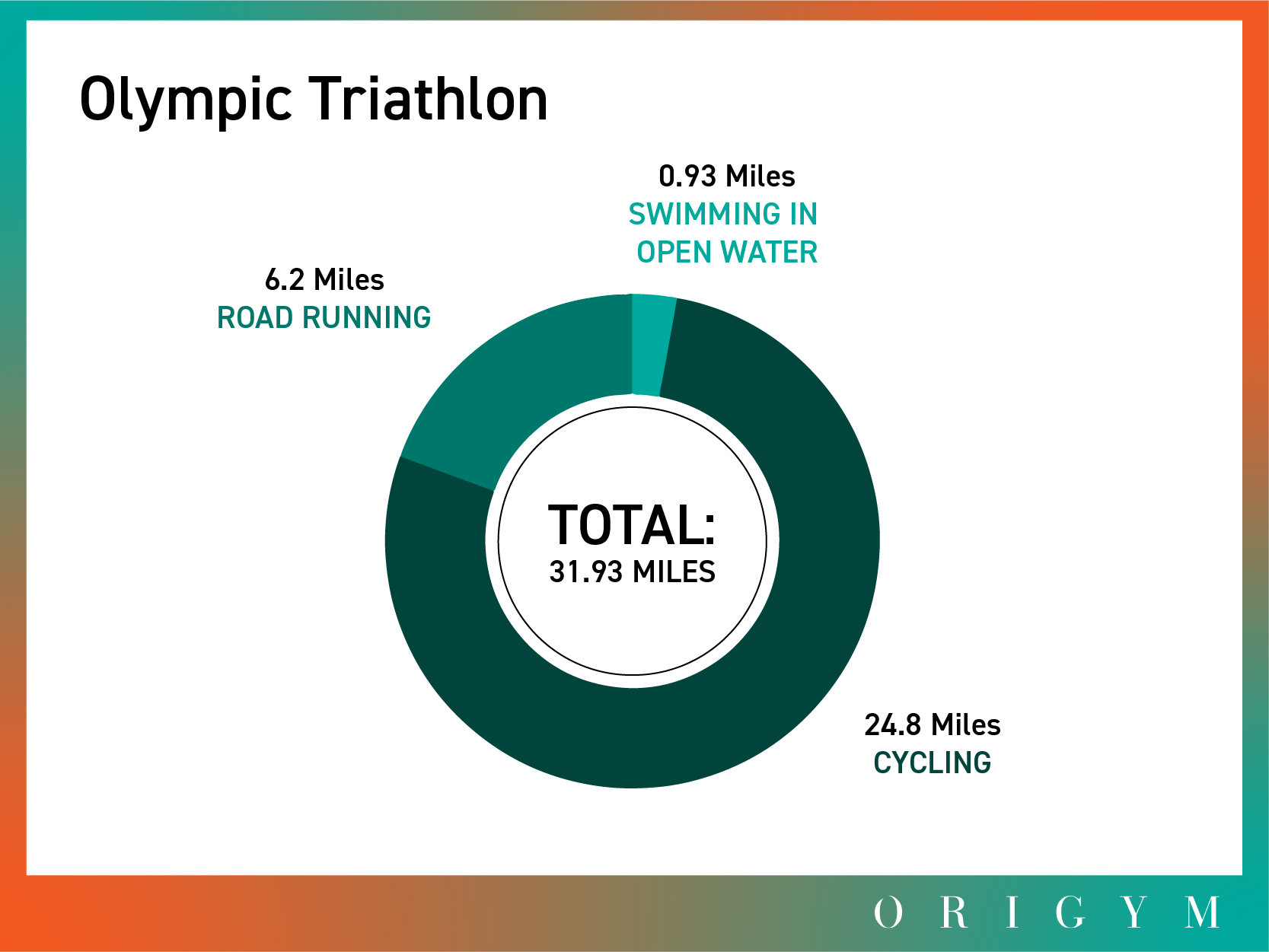
This event requires great levels of endurance and stamina, but if you wish to pursue Olympic triathlons you should be aware that they are double the distance of sprint marathons, so you must be incredibly dedicated to your training schedule.
If you’re interested in making the jump from sprint to Olympic triathlons, you should focus on building up endurance, by performing a sufficient amount of strength work. Injury-proofing your body is important when participating in triathlons of this length and distance.
The average athlete should take on average 3 hours, whilst professionally trained athletes or those who are placed into the top age groupers should be able to complete the course in around 2 hours or less.
Olympic triathlons take a great deal of intensity, not only are transitions incredibly quick, but on average athletes maintain a pace of 5-minute mile runs!
Training Schedule
In order to train for an Olympic style triathlon it is recommended you focus on building muscle memory. Try to put minimum effort in throughout your exercise before really pushing yourself at the end of each practice.
Try your best to do two of the workouts a day with some rest days in between, for example:
- 20 minute swim followed by a 40 minute run on Mondays
- Rest day on a Tuesday
- 35 minute run followed by a transition into 20 minutes of cycling on a Wednesday
- At the end of the week, small race simulation, where you practice each event in succession.
This is pretty intense so remember, your body is different from everyone elses, don’t take the example recommendation as the definitive answer to training. Instead, accommodate it around you and focus on maintaining your strengths whilst improving your weaknesses; however the biggest piece of advice we can give is consistency - stay focused and stick to your routine!
Where to Sign Up
If you’re a resident of the UK and are looking to participate in an Olympic triathlon, LetsDoThis are again, a great platform to reference. It’s here that you’ll be able to find all of the active Olympic triathlons that are happening around the country.
Further Considerations
Much like the sprint triathlon, the age category for the Olympic triathlon follows the same 4 year class of separation. However, unlike the sprint triathlons the age categories within this event may be somewhat stricter. This is because some enter the Olympic triathlons in order to qualify for competitions such as world triathlons.
Within these events another ‘age group’ may appear in the form of elite males and females. This isn’t age specific per say, but rather this category is comprised of athletes that have either placed high in previous olympic or world events or have self entered themselves into this category after finding success elsewhere.
You shouldn’t need to worry about this category unless you expect to finish in the top 1-3% of athletes.
You never know what the weather will be like on the day of the race, so prepare for running in hot weather with our tips and precautions.
#3 Half Ironman

In the world of triathlon distances, UK particularly - the half ironman distances are perhaps the most popular event to feature on this list. Whilst half triathlon distances may sound easy in theory, they can be just as tricky as events that require you to run the full triathlon distances.
Distances
In miles the half ironman distances consists of:
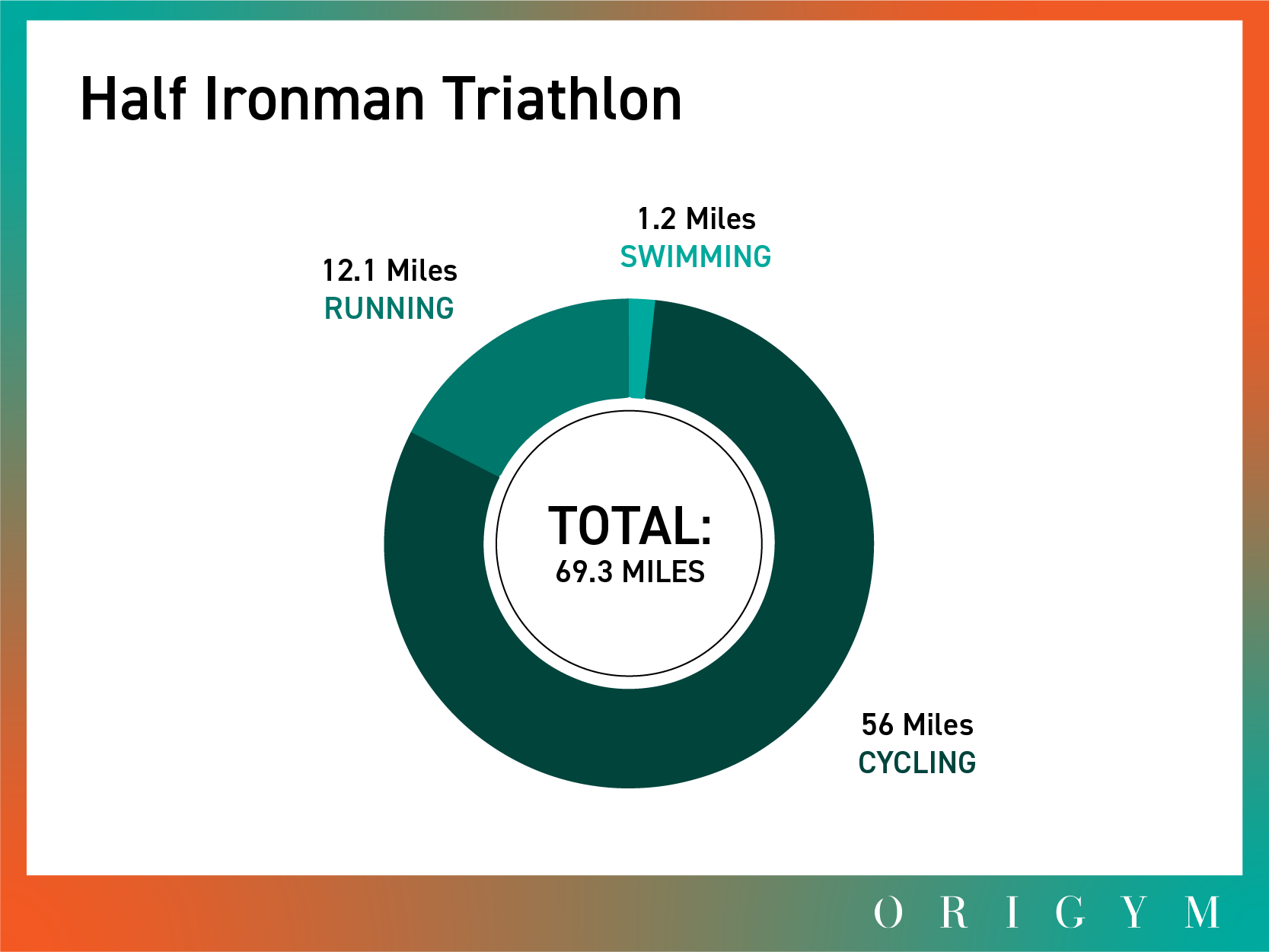
The half triathlon distances are often advertised as being a ‘70.3 event’; this is simply a total sum of the distance that you will travel during the event. If you ever see a race that is advertised as such, it will be regarding a half ironman triathlon.
Compared to full ironman distances, the half ironman distances require significantly less commitment in terms of speed, training and dedication. However if you’re a relatively new triathlete previously competing in only sprint and olympic triathlons, you may find running half ironman distances to be a challenge.
Competing in a 70.3 event requires the perfect balance of endurance, stamina, speed and efficiency and if this is your first time competing in a half ironman triathlon, you’ll notice that the professionally trained athletes will speed ahead, as the pace required for this event is incredibly fast!
On average, the event should take an ammeture triathlete a total of 6-7 hours to complete the course, however professionals are likely to complete the course in a total of 4-5 hours.
The super impressive current record for completing the half ironman distances is held by the South African world champion Jan Frandedo, who completed the event in a total of 3 hours 36 minutes!
Overall, the time taken to complete the half ironman distances are subjective and this is likely due to the difficulty of the course, even the highest caliber of athletes in their age groups will see their time affected by strenuous courses.
On average, if a course is more challenging professionally trained athletes will see an hour added onto their final time, often completing the course in a total of 5-6 hours.

Training Schedule
In terms of training, whilst developing your own training schedule has been a good idea for the previous two entries on this list, we would recommend hiring a triathlon coach if you intend on running the half triathlon distances.
Working with a coach who specialises in this area will be beneficial to you in the long run, as they will not only be helpful for motivation but will also hold you accountable when you’ve pushed yourself too hard or not hard enough.
Tackling a challenge as big as running a half ironman triathlon will require professional guidance, especially if you’re an ammeture athlete who’s entering one for the first time. In addition to this, these trainers will be able to give you first advice on a one to one level, bracing you for what you may feel and encounter during the various stages of the event.
If you’re interested in pursuing triathlon training but 1-2-1 training doesn’t work for your schedule or for your personal comfort, we would recommend signing up for online training. The site BetterTriathlete has launched an online training platform for athletes to sign up for, simply complete the form based on your specific conditions.
Half triathlon distances are considered to be the most popular event for racers looking to improve their skill level; additionally being popular among ammature athletes who are looking to become more involved within the world of long-course racing.
Where to Sign Up
Due to their popularity, half ironman triathlons tend to sell out faster than any other triathlon to be featured on this list. We have included LetsDoThis again, as they provide a list of half ironman triathlons in your area.
Be aware that these triathlons will be limited to a few thousand competitors, so get your registration in early if you wish to participate.
Further Considerations
In terms of age grouping, this works a little differently, as there is a change in how the groups are split up. The youngest category in half-ironman typically range between 18-24 and in terms of the triathlon distance and time it is this age group that completes the task in the fastest time.
However, following this category the others will follow the standardised 4 year age gaps, with the next age group consisting of athletes who are 25-29.
Explore career opportunities in the industry by understanding the top-earning fitness positions.
#4 Full Ironman

When it comes to triathlons, the ironman is arguably one of the most challenging courses an ammature can compete in. As the name suggests, the distances for ironman triathlons are double that of the half ironman.
Distances
In terms of miles, the distances of ironman consist of:
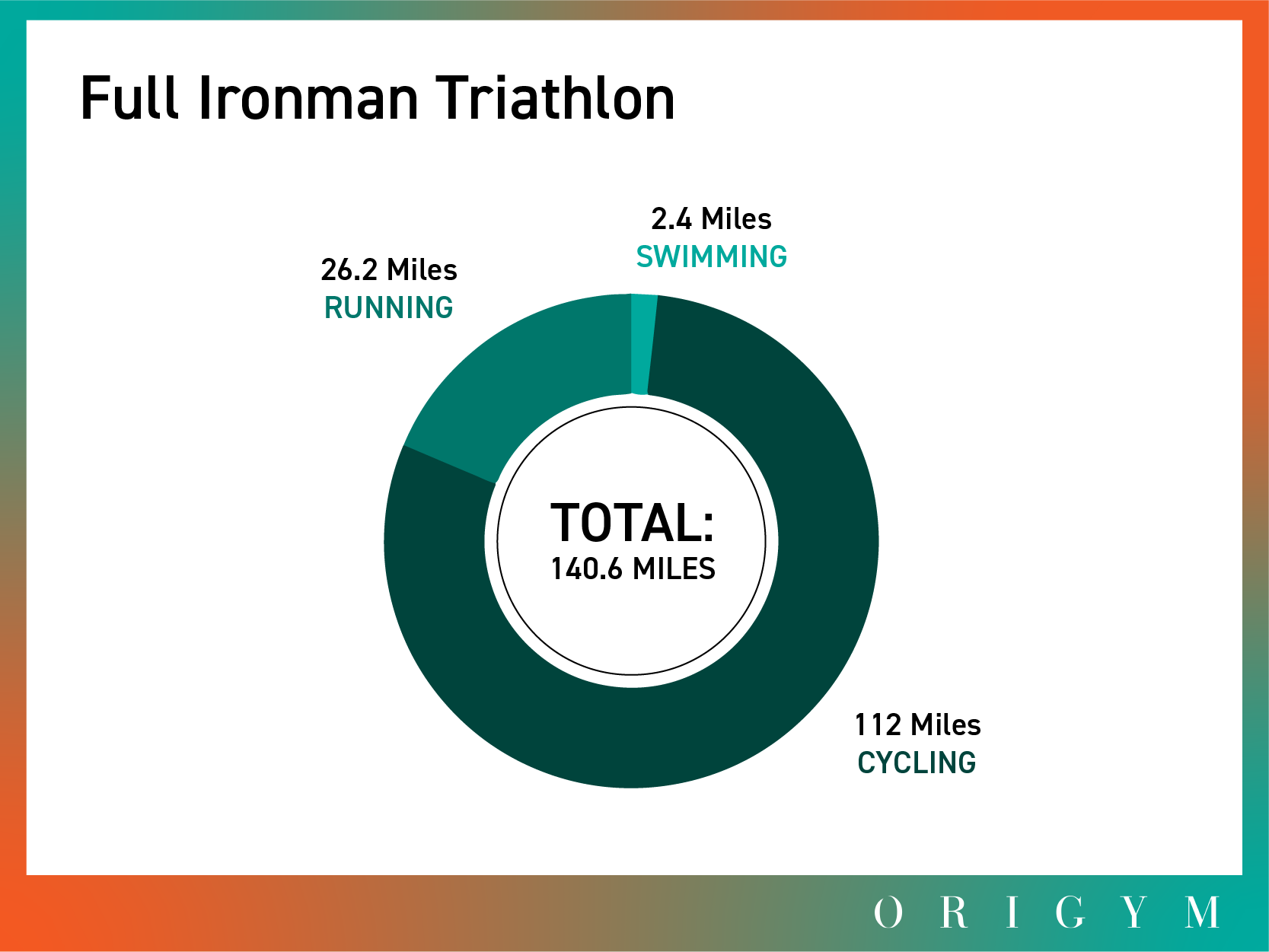
Completing ironman distances will require a high level of fitness and mental endurance. The latter of which often goes overlooked, many people fail to recognise the emotional strain training for and completing ironman triathlon distances can have on your mind.
In order to give you an understanding of how long the event can be, the current world record for completing the ironman triathlon distances stands at 7 hours and 40 minutes.
Professionally trained athletes, who are at the top of their age group usually complete the course in around 8-9 hours and comparing this to amateurs, we can see them completing in just over 10-12 hours.
However, this is where training can be the differentiating feature, committing to the distances of ironman triathlons will require a total change in lifestyle and unlike the other entries on this list, it is not as simple as training for an hour or so a day.
Athletes who enter the race with minimal training under their belt will see their overall performance affected, as on average they finish the event in times over 13-14 hours.
Training Schedule
It’s a serious statement when we say that triathlon training becomes a lifestyle, as whilst athletes of any kind can expect to change their fitness and dietary lifestyle, tackling the ironman triathlon requires an entire social lifestyle change too.
Many triathletes have noted alterations to their social circles, with time spent with family and friends becoming more distant and infrequent due to training times. Similarly, other athletes have reported financial savings altering in order to fund training, many athletes pour everything they have into the pursuit of the full ironman.
However, it's important to note that this is not the healitest approach to take when attempting to tackle any sport or race of any kind. Always remember to take care of yourself when training, play to your strengths and be sure to never skip rest days. Everything you do can be beneficial in your pursuit of completing an ironman but don’t let it consume your life.
Find out the importance of rest days and how often you should take them over at our article.
We would recommend some of the following tips for any aspiring athlete who is looking to complete the ironman triathlon distances. Taking advantage of ‘light days’ can be beneficial when pursuing your goals.
For example, if you spend one hour or more a day playing golf, why not incorporate a swim following a game in order to train whilst also relaxing your back muscles in the process.
In addition to this, it is absolutely vital to incorporate both strength and speed training into your workouts. In terms of speed training, many ammature athletes take an approach where they focus solely on long temp or lactate threshold intervals.
However, doing short bursts of ‘all out’ effort may also be greatly beneficial to your training program too.
In terms of speed, whilst it is important to challenge and push yourself, pacing is also of great importance. The European University of Madrid found that ironman athletes who regularly paced themself through training with short bouts of intensity performed 70% better than athletes who continuously pushed themselves.
So, in the case of completing these full triathlon distances high speed isn’t everything, consistent speed is the key. Instead of rushing into the event wanting to speed through it, take your time as it's likely that you’ll tire yourself out too fast and end up with a worse overall time.
Regarding strength training, it is vital you incorporate this into your fitness program year round, not just during the season in which you’re looking to complete the distances for ironmans. Further, when you’re in an off season, try and incorporate strength training 2-3 times a week into your workout schedule.
When it comes to preparation, once again we would recommend looking into online or in person training for this event. If you’re a new triathlete it is beneficial to have a network of support and advice ready at your fingertips, so use any of the tools around you to your advantage.

Where to Sign up
If you wish to take part in any ironman triathlons UK located, LetsDoThis is the best place for the information that you need, regarding registration for an event in your area.
Ensure that you are prepared before signing up, as this strenuous event takes heaps of time and effort to perfect.
Further Considerations
When it comes to the ironman age categories, they conform to the same age groupings as the half-ironman. The 18-24 year olds will be grouped together and on average perform the best out of any age category, likewise the 25-29 will be grouped together and so on in 4 year intervals until the final age group of 80+.
Due to its length many ironman triathlons will also allow you to enter in a relay team of 2-3 people, with one person taking each event for the team. The relay teams will be a separate age group entirely, with everyone competing together from ages 18-80.
However, be aware that this is not applicable to every ironman triathlon, so if you wish to compete in a team relay event, make sure that your chosen ironman triathlon offers this.
Become a Personal Trainer with OriGym!
- Qualify & start earning in just 2 weeks
- Study full-time, part-time or online
- Endorsed by CIMSPA
#5 Double Ironman Distance/Ultra Triathlon Distance
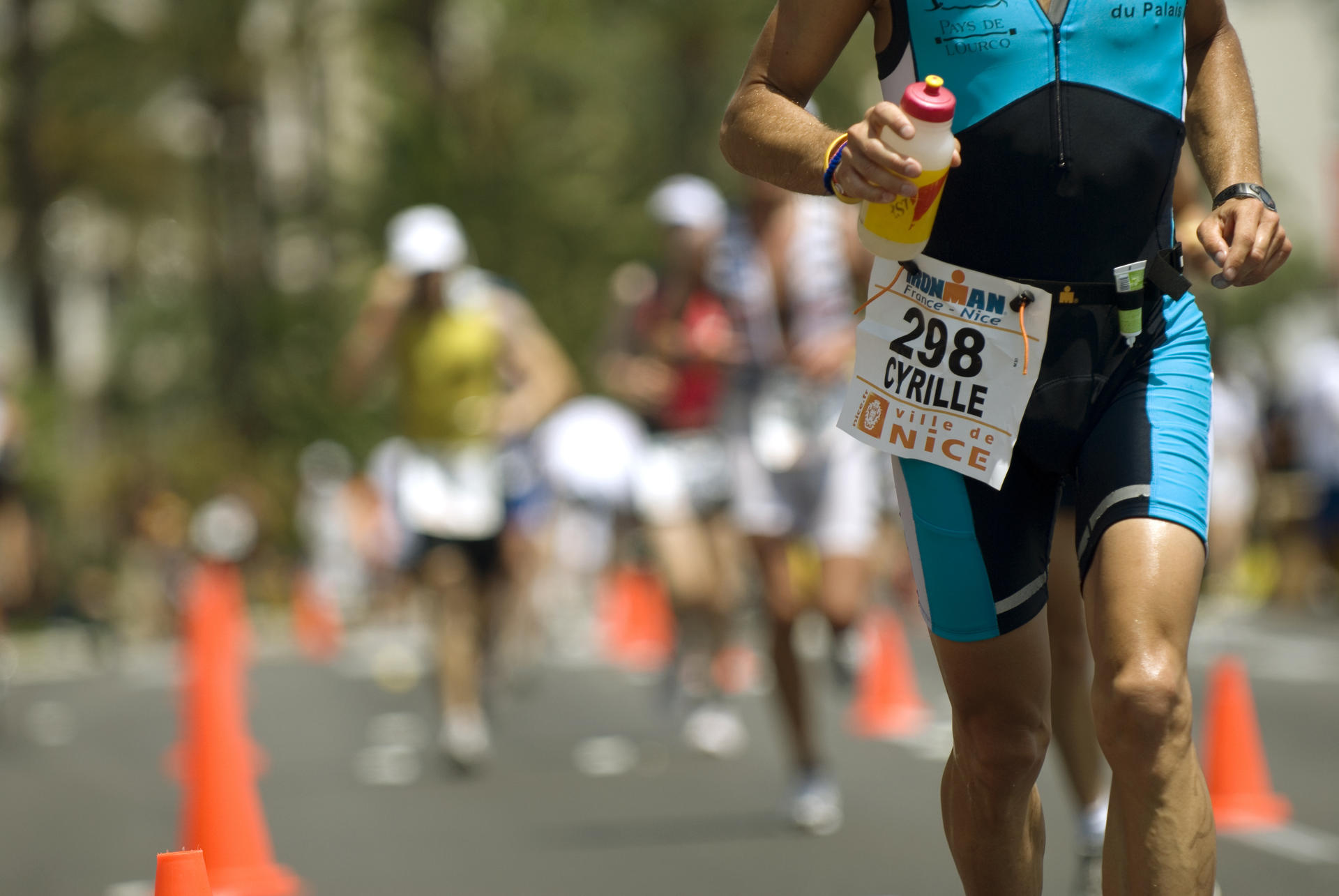
For those of you who mastered the ironman UK distances and want yet another challenge, you may want to try your hand at an ultra triathlon challenge. Ultra triathlon distances are effectively multiples of all ironman challenges.
For example if you refer to this distances chart you can see that ultra triathlons are broken down into categories such as ‘double iron’ and ‘triple iron’.
Distances
The distances chart shows that as the name implies a double iron will be double the length of ironman including:

These events are not for the faint of hearted, ultra triathlon distances are even extremely difficult for professionally trained athletes to undertake.
The world record for the fastest compilation of an ultra triathlon goes to Jan Frodeno of Germany who completed the double ironman in 7 hours and 30 minutes.
For perspective, the next closest male time comes in at 18 hours and 44 minutes but it's important to remember that these are trained athletes who have dedicated their life to the sport. Ammature times for ultra triathlons are difficult to come across, so be aware that your completion time may be significantly longer than 15 hours.
We would recommend getting a few years worth of experience under your belt before you even think about approaching such a feat. However, if you’re brave enough to tackle any one of these ultra triathlons we can pass along some information that we think you may find useful.
Training Schedule
Prepare everything in advance, if you fail to prepare then prepare to fail as the old saying goes. We have already recommended making a weekly and monthly training plan for other triathlons, however after considering ultra triathlon distances, training plans need to be much more intense.
Try to make a year long training plan, this way you can set your goals and ambitions for the years ahead. Additionally, make sure you make note of your achievements too, knowing what you have already achieved will be beneficial when it comes to challenging yourself during the training process.
Many professionally trained tri-athletes recommend training intensely for this event, but take things easy during the race itself. This will allow you to build your strength and endurance which you can store for the race itself - but why is this?
In terms of health and safety, if you push yourself too hard during training and require assistance then you will have help by your side, be it at the gym or pool. However, if something goes wrong after you’ve pushed yourself during the actual event, then you may potentially be putting yourself in danger.
Another good idea is to join some groups on social media, it's here that you’ll get a wide variety of advice from people all over the world. Some advice that is given just may not be right for you as everyone’s bodies are different, so you need to be ready to take this advice and alter it slightly to work for you.
The final piece of advice we can offer when training to complete ultra triathlon distances, is to train with the course in mind. If the running section will be on mountain terrain, try to train on a similar type of ground.; allow your body to become accustomed to the elements it will face on the day of the race.
Where to Sign Up
Registering for this event isn’t as easy as the other triathlons to feature on this list. Many such as The UK’s Monster Triathlon and Racing Quest will require proof that you have previously completed a regular ironman triathlon before competing.
In terms of ultra triathlon distances and times, they can be very subjective depending on what kind of ultratriathlon you choose to compete in. Likewise, something that is also subjective is the age groups of those competing.
Further Considerations
Some ultra triathlons will only have very limited numbers of slots to compete such as Racing Quest which only allows 50 racers a year. It is for this reason, that age groups aren’t a huge factor in ultra triathlons.
#6 World Triathlon

If ultra triathlons are considered to be the most challenging form of triathlon, then world events should be considered to be the most professional triathlon events.
The event is comprised of the most elite triathletes in the world, they may qualify to compete in this race by either having placed highly in previous races or are in the elite age group of previous events such as Olympic triathlons.
Distances
The world triathlon distances may vary from race to race, as the championship series events typically take place within 8 of the world's great cities. However, the standardised procedure that world triathlon distances may adhere to are:
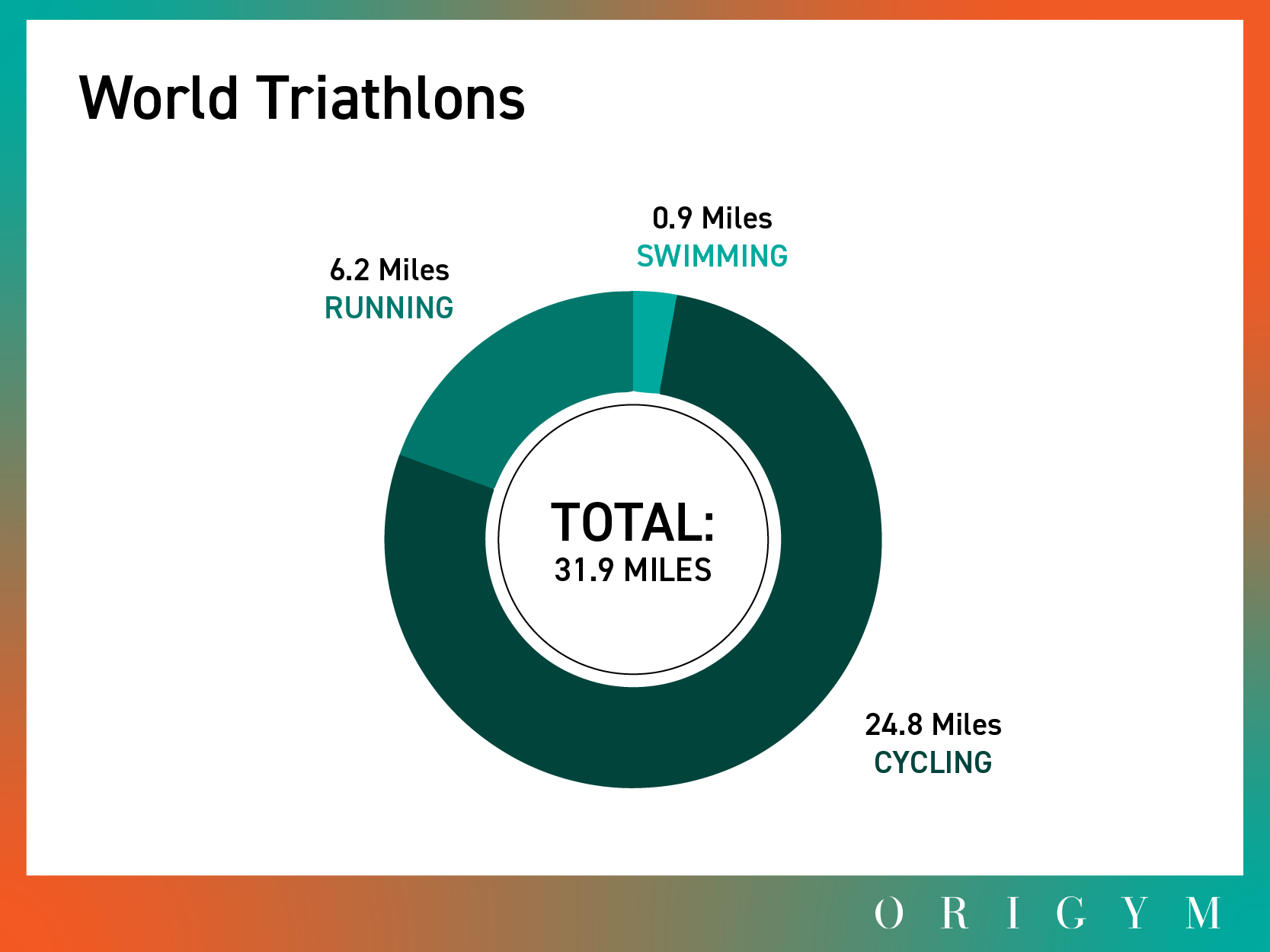
Because they are a competitive sport, the world events are less about distance and endurance and more focused on speed. For example, in the most recent world championship series to be held in Leeds, the fastest competitor Vicky Holland completed the track in 1 hour and 56 minutes. Beating her runner by just 0.20 seconds.
Where to Sign Up
Due to the sheer difference of speeds and expertise of athletes taking part, the time taken to complete the race is extremely subjective.
In terms of qualifying the first thing you have to do is sign up with your home association be it:
Signing up for these home associations will save you lots of money when it comes to having a day licence for your run. After this, you will be able to decide which world championship event you wish to qualify for; note that you’ll need to register your intent before 5pm on the Friday before the qualifying race.
Training Schedule
Whilst the world triathlon distances may not be too far, in comparison to other popular triathlon events, the competition is arguably at the greatest intensity.
Unlike the other triathlons that have recommended training schedules, the training undergone will be entirely individualistic to the participant and due to its competitive nature, many athletes keep their training regime a secret.
If you’re struggling to maintain a consistent training routine, we would recommend getting into contact with your home association for further guidance or hiring a personal trainer.
Further Considerations
However, actually qualifying is easier said than done. New ETU European Championship guidelines set out by the BTF dictate that you must complete the course within 120% of the winner of your qualifying triathlon and if you’re interested in competing in the ITU World Championships, then you’re going to need to qualify with 115% of the winning age-group time.
#7 Junior Events

As we draw this list discussing what are the different triathlon distances to a close, we turn now to events that are held for children and young adults, as the sport is growing in popularity, the frequency of junior events occurring has steadily increased. All across the world junior triathlons are finding success, however it is important to note that all junior triathlon distances will be significantly shorter than adult ones.
Distances
Regular junior triathlon distances tend to increase as the age groups of the competitors do. For example, the UK based junior triathlon distances can be seen in this distance chart; the 5-7 year old category will compete in a:

This will then increase when it comes to 8-11 year olds, who will conduct:

Many different governing bodies will follow this youth triathlon distances regulation. For example the British Triathlon organisation demonstrates a similar distance chart, where the distance of all the events will increase with the age groups.
Training Schedule
The key to training children to complete youth triathlon distances is to make training as fun as possible. Unlike adults, children are not driven by how fit they want to be, they are driven by how fun something is.
Additionally, ensuring that your children have a well balanced diet and get plenty of sleep will also help them greatly when competing in these kinds of events.
When it comes to training children to swim, the most effective method has been to place them into swimming classes with other children their age. In these classes they can be encouraged to swim up to 3 times a week, as well as attending galas on the weekends.
This similar technique can be used when teaching children to enjoy running and getting involved in mini-triathlon distances, by encouraging them to participate in athletics clubs. The kind of guidance children get from coaches in these classes will be incredibly beneficial to the final goal of completing the mini triathlon distances.
When it comes to cycling it's a good idea to incorporate it into a family day and getting children riding on bikes whenever possible. So whether you’re going to the park or to a relatives home, bring the bikes and encourage them to peddle the entire way!
Further Considerations
It is important to guide children’s focus if your child is wanting to complete mini-triathlon distances.
They should not be focused on one event more than the other, placing them into after school clubs will be beneficial in the long run, but if the ultimate end goal is to complete the mini triathlon distances then their efforts should be evenly distributed throughout all sports groups.
FAQs
What Equipment and Gear do I need?

If you have any intentions in competing in any of the above activities, we would recommend purchasing the following equipment:
- Wet Suit - This may occasionally be mandatory to wear by the event organisers, but even if it's not mandatory we would recommend purchasing one. The wetsuit can keep you warm as well as maintaining your buoyancy in the water, look for a wetsuit that fits tightly but does not restrict your range of motion
- Tri-Suit - A tri-suit is very similar to a wet suit, it is specifically designed to dry off quickly after the swim and provides your body with cushion as you cycle while also allowing you to move freely during the run. The same advice as the wetsuit applies, look for something that is tight but not restrictive.
- Goggles - This is a surprisingly vital piece of equipment. You don’t want to get ones that are too loose and will fall off, alternatively you don’t want to get some too tight that can cause discomfort. The right size will act like a vacuum seal and protect your eyes from water damage. Likewise, if you think it may rain on the day of the triathlon we’d recommend buying a tinted pair.
- Sunglasses - These are hugely important for the biking and running sages. Whether they’re protecting your eyes from the sun, wind, rain or flying insects a decent pair of sunglasses is a must!
- Helmets - Another necessary piece of equipment that you need in order to compete. The only advice we can give you is when trying on helmets, be sure to bring your sunglasses with you. In order to see if the glasses and helmet can fit comfortably on your head at the same time.
- Socks - Some triathletes would never dream of putting on socks when there is valuable time to be had during transitions. However, if you’re someone who couldn’t go without then we’d recommend moisture-wicking double layered pairs.
- Running Shoes - Don’t take any chances and don’t shop online. Go and try on pairs in person, in order to see which pair is most comfortable for you.
- Elastic Laces - This is for all of you who want to improve your overall time score. Don’t waste a single second tying laces, instead buy simple elastic ones, snap on and go!
What is a Tri-Bike and Should I Invest in One?

The triathlon bike is very similar to regular bikes with a few key differences. For starters, the tri bike has a wider seat that is angled at 78 degrees.
This allows for a much more aerodynamic performance when competing in the cycling events. Thanks to this design the bike handles very well on flat dry terrain, if you’re looking for a bike that will help you with uphill events, then we’d recommend purchasing a road bike instead.
How do I Get Started?

Getting started to dive into beginner triathlon distances can seem daunting, but even the most successful tri-athletes started right from the beginning. The most important thing is to recognise where you’re going to begin, choose your triathlon style and start to train accordingly.
It's recommended to train for a minimum of 12 weeks before jumping into triathlons, we recommend even more for the likes of Iron Man triathlon distances. Focus separately on cycling, swimming and running and ensure to practice them all together to prepare for transitions during the race.
One other thing to remember is that if this is your first race, write yourself a race day checklist to ensure you don’t forget vital necessities - refer to our equipment list above if you need some help.
The next step is to find your local race, by now you are aware of LetsDoThis as we mentioned them throughout, so if you head to their website you can find the logistics of the races near you.
Before You Go!
We hope you have found our guide into the different kinds of triathlon distances, to be informative and useful to your practice. If you are undertaking a triathlon for the first time we wish you the best of luck in this latest venture!
Remember it's important to pace yourself, don't throw yourself in the deep end, use your time wisely and train to the best of your ability and develop your craft.
One more thing, if you want to be a professional in the fitness industry, take a look at our L3 PT Diploma on offer here at OriGym; alternatively, you can browse all of the courses we provide in our prospectus that you can download for free.
Start a Successful Online PT Business From Home in 9 Weeks!
Get started by downloading our video guide
References:
- Iker Muñoz, Roberto Cejuela, Stephen Seiler, Eneko Larumbe, Jonathan Esteve-Lanao. (2014) Training-intensity distribution during an ironman season: relationship with competition performance, European University of Madrid.
Ready to transform clients lives?
Now you can with OriGym's PT Diploma!

